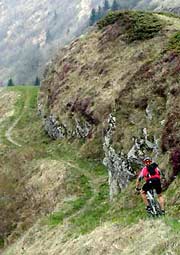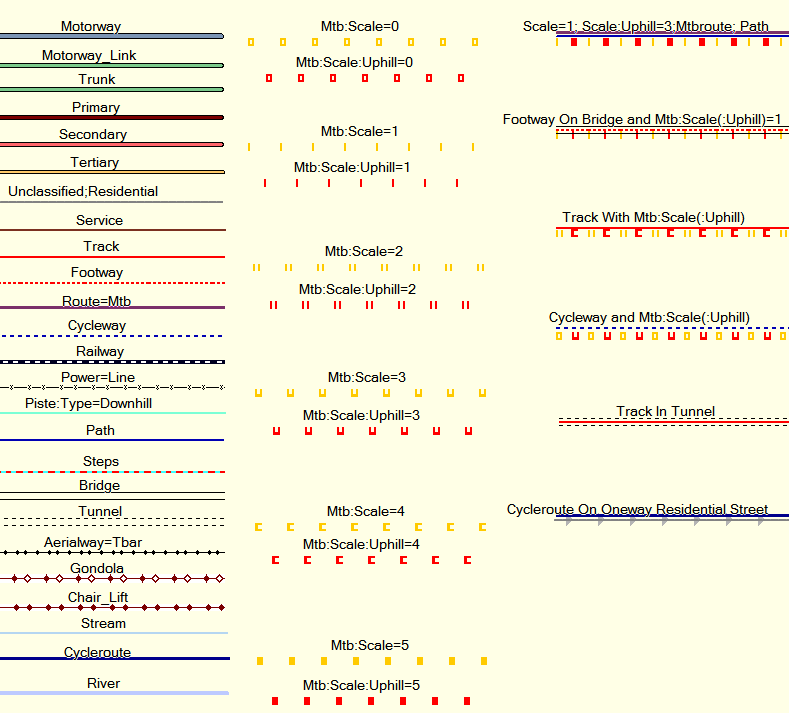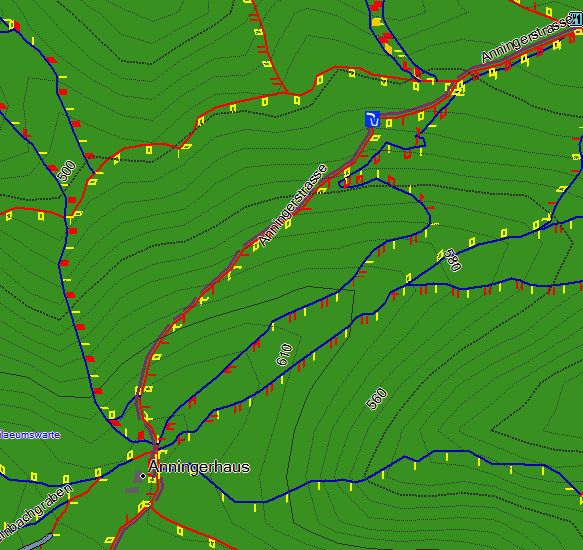JA:Key:mtb:scale
 |
| 説明 |
|---|
| マウンテンバイクでの走行の難易度を分類する方法 |
| グループ: 自転車 |
| 適用できる要素 |
| よく併用されるタグ |
| 状態:承認 |
| ツール |
原理
道のマウンテンバイク向けの難易度をマッピングする際の分類方法を提供します。マウンテンバイクは上りと下りとで難易度が異なるため、平坦ではない場合は、個別にタグ付けします。
これはマウンテンバイクに関する様々な提案の中の1つです。
適用先
マッピング方法 - 使用方法、タグ、値
The main key to be used is mtb:scale=0 to 6. This shall be used for classifying the level of difficulty of using a trail that is more or less level (no inclination) or is used for riding down. Additionally one can tag mtb:scale:uphill=0 to 5 to specify the difficulty of a way cycling uphill (it is best used with incline key, to express the direction of the way).
If a finer seperation is needed than provided by the 7 classes, "+" or "-" can be added to the value. E.g. mtb:scale=1+ for ways on the upper difficulty of "1", but not yet "2".
mtb:scale applies primarily to ways. The difficulty should be based on the general difficulty over a longer stretch of a way, there can be a few places where the difficulty is higher. Those places should be classified on a point of the way.
難所や困難な地点
In order to highlight spots on a way, that feature a difficulty that is clearly more difficult than the way in general (e.g. one full grade more difficulty), on can highlight them by placing a node on the way with the difficulty to clear that node (do not highlight every switchback of a way however). If you put a point with mtb:scale=1-6 (0 makes no sense) outside of the way, then this shows a place that is more difficult, but can be circumvented.
mtb:scale=0-6
The main tagging scale.
| タグ | 説明 | 最大勾配 | STS 評価 | 画像例 |
|---|---|---|---|---|
| mtb:scale=0 | Gravel or packed earth. No particular difficulties. Mostly forest and meadow paths (highway=path). Sections with steps, rocks, or roots are not expected. Wide curves, easy to moderate slope. No special skills are needed to ride this. Easy to ride uphill.
For very easy ways you can use mtb:scale=0- for harder ones (but not yet mtb:scale=1) mtb:scale=0+ |
- | S0 | 
|
| mtb:scale=1 | Smaller obstacles like roots and small stones. Erosion damage may increase difficulty. Soil may be loose in places. Tight turns, but no hairpin turns. Riding requires care and attention, but no special skill. Obstacles can be ridden over. Difficult to ride uphill.
|
<40% | S1 | 
|
| mtb:scale=2 | Obstacles such as large rocks and stones. Soil is often loose. Steps are expected. Wider hairpin turns, steepness of up to 70%. Requires some advanced riding skills. Only very skilled riders can go uphill on this.
|
<70% | S2 | 
|
| mtb:scale=3 | Many sections with large obstacles such as boulders and large roots. Many hairpin and off-balance turns. Slippery surface and talus sections may be found. The surface may be very slippery. Constant concentration and very good skills needed. Nearly impossible to ride uphill.
|
>70% | S3 | 
|
| mtb:scale=4 | Very steep and difficult, with sections having large boulders and roots. Frequent loose debris. Very steep sections with very tight hairpin turns and high steps that will cause the chainring to hit the ground. Some trials techniques will be necessary. Nearly impossible to ride uphill.
|
- | S4 | 
|
| mtb:scale=5 | Very steep and difficult with big boulder fields and debris, and landslides. Speed must be carried for counter-ascents. If at all only short passages are available for accelerating and braking. Fallen trees may make very steep passages even more difficult. Very few Mountainbikers can actually ride at this level. Most will have to push.
|
- | S5 | 
|
| mtb:scale=6 | Classify ways with 6 that are not rideable at all for a mtbiker. E.g. Chains or stemples (metal rungs) on a via ferrata or simply unsecured alpine pathes that are not even partly rideable for the very best mtbikers (using trial techniques). Steepness is often >45°.
If used for single points, then this highlights exceptionally difficult spots. Often spotting is impossible and falling may be lethal.
|
- |
mtb:scale:uphill=0-5
In the case you want to be more specific about the difficulty for going uphill. Please don't forget to also use the Key:incline on such ways so that routing software can make the way oneway. Especially for mtb:scale:uphill=4 and mtb:scale:uphill=5.
| タグ | 説明 | 平均勾配 | 最大勾配 | 障害物 |
|---|---|---|---|---|
| mtb:scale:uphill=0 | Graveled or hardened earth. Good Grip. Usually a highway=track. Even unskilled mountainbikers can ride up here easily. Cars with good tire clearance can go down or up without problems. | <10% | <15% | None |
| mtb:scale:uphill=1 | Graveled or hardened earth. Good Grip so wheelspin (also when standing) does not happen when taking care. Steep forest track or easy to ride footpath. | <15% | <20% | Some loose objects may lay on the trail but are avoidable |
| mtb:scale:uphill=2 | Mostly stable, unsurfaced, partly washed out, steady pedalling and ballance needed. With good technique and reasonable fitness this should be still doable however. | <20% | <25% | Fistsize loose rocks, roots or rocky underground |
| mtb:scale:uphill=3 | Variable Surface, tight corners, small steps, surface is rocks, earth or gras. Very good ballance and steady, round pedalling needed. Without very good skills mtbikers have to push their bike uphill | <25% | <30% | Fistsize loose rocks, roots and branches or rocky surface |
| mtb:scale:uphill=4 | Way is very steep, or in bad condition for pedalling uphill. Steps, trees, roots and tight corners are present and even good and strong mountainbikers will have to push or carry their bike for parts of the way | <30% | <40% | Big loose rocks, big branches across the trail, rocky or loose surface |
| mtb:scale:uphill=5 | Way is too steep and/or difficult to ride uphill. We need this level for signalling to other mtbikers that on this part they have to push and carry the bike. | - | - | - |
Notes to Usage of the scales
注意事項
- "Equivalent to STS" means equivalency to the german Singletrail-Skala v1.4 as found here [1]; upon which this scale is based.
You may also find a more in-depth description of the scale on that page, with more photos (just click on S0 to S5 in the upper bar to get more detailed descriptions and pictures for each level).
- The example photos of the STS scales are from http://www.singletrail-skala.de/ and may be reused under cc-by-sa-2 or cc-by-sa-3.
- If you click on the STS Equivalency links, you are linked to the respective difficulty grades on www.singletrail-skala.de. There are more pictures for each scale to give a better visual impression about each grade.
- Note mtb:scale only applies to the technical difficulty of mountain biking on a trail. It says nothing regarding the legal situation. For trails where cycling/mountain biking is explicitly forbidden add bicycle=no. For trails there mountain biking/cycling is implicitly forbidden there is no key yet.
使用例
If only one condition is met, the respecting scale should be used. E.g.
- a way with gradient 50% has to be tagged mtb:scale=2 or higher. Additional to signal to everyone that this way is steep mtb:scale:uphill=5 is needed.
- a way with loose surface possible, small roots and stones that goes flat is still mtb:scale=1 and not lower mtb:scale=0. mtb:scale:uphill is not needed.
- a way with loose surface possible, small roots and stones that goes at an average incline of 25% is mtb:scale=1 and mtb:scale:uphill=3. This is a good example for a way that is quite easy to go down, but very difficult to go up.
mtb:scale:imba=0-4
Garmin Mapsource を使った mtb:scale のレンダリング例
関連項目
- Approved_features/mtb:scale
- マウンテンバイク - マウンテンバイク向けのタグ付け方法に関する全般的なページです。
sac_scale=*- ハイキングコースの分類方法

